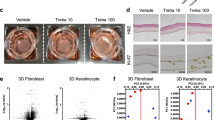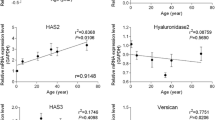Abstract
Although it has been reported that levels of hyaluronan are decreased in the dermis of aged skin, little is known about the cellular mechanism(s) underlying that hyaluronan deficiency. Since hyaluronan is produced by dermal fibroblasts and is secreted into the surrounding dermal tissues, we examined the secretion of hyaluronan by dermal fibroblasts and characterized its cellular mechanism using real-time RT-PCR and western blotting for its synthesizing and degrading enzymes, hyaluronan synthase and hyaluronidase, respectively. The secretion of hyaluronan by dermal fibroblasts derived from differently aged human donors, was higher in the younger human fibroblasts tested (0 and 19 years old) compared to the older human fibroblasts tested (39, 56 and 77 years old). The relative secretion levels of hyaluronan by the different human fibroblasts tested were attributable to the relative expression of hyaluronan synthases 1, 2, 3 but not hyaluronidases 1, 2 enzymes at the gene and protein levels among those fibroblasts. These findings indicate that the deficiency of hyaluronan in the aged dermis might result from the down-regulation in the potential of older human fibroblasts to secrete hyaluronan and that decrease in secretory potential is mainly associated with the down-regulated expression of hyaluronan synthases, especially hyaluronan synthase 2, but not with the expression levels of hyaluronidases.





Similar content being viewed by others

Abbreviations
- HA:
-
Hyaluronan
- HAS:
-
Hyaluronan synthase
- HYAL:
-
Hyaluronidase
- NHDFs:
-
Normal human dermal fibroblasts
- UVB:
-
Ultraviolet B
References
Averbeck M, Beilharz S, Bauer M, Gerbhardt C, Hartmann A, Hochleitner K, Kauer F, Voith U, Simon JC, Termeer C (2006) In situ profiling and quantification of cytokines released during ultraviolet B-induced inflammation by combing dermal microdialysis and protein microarrays. Exp Dermatol 15:447–454
Dai G, Freudenberger T, Zipper P, Melchior A, Grether-Beck S, Rabausch B, de Groot J, Twarock S, Hanenberg H, Homey B, Krutmann J, Reifenberger J, Fischer JW (2007) Chronic ultraviolet B irradiation causes loss of hyaluronic acid from mouse dermis because of down-regulation of hyaluronic acid synthases. Am J Pathol 171:1451–1461
Elias JA, Krol RC, Freundlich B, Sampson PM (1988) Regulation of human lung fibroblast glycosaminoglycan production by recombinant interferons, tumor necrosis factor, and lymphotoxin. J Clin Invest 81:325–333
Fisher GJ, Datta SC, Talwar HS, Wang ZQ, Varani J, Kang S, Voorhees JJ (1996) Molecular basis of sun-induced premature skin ageing and retinoid antagonism. Nature 379:335–339
Fisher GJ, Varani J, Voorhees JJ (2008) Looking older: fibroblast collapse and therapeutic implications. Arch Dermatol 144:666–672
Fisher GJ, Quan T, Purohit T, Shao Y, Cho MK, He T, Varani J, Kang S, Voorhees JJ (2009) Collagen fragmentation promotes oxidative stress and elevates matrix metalloproteinase-1 in fibroblasts in aged human skin. Am J Pathol 174:101–114
Hata R, Sunada H, Arai K, Sato T, Ninomiya Y, Nagai Y, Senoo H (1988) Regulation of collagen metabolism and cell growth by epidermal growth factor and ascorbate in cultured human skin fibroblasts. Eur J Biochem 173:261–267
Heldin P, Laurent TC, Heldin CH (1989) Effect of growth factors on hyaluronan synthesis in cultured human fibroblasts. Biochem J 258:919–922
Itano N, Kimata K (1996) Molecular cloning of human hyaluronan synthase. Biochem Biophys Res Commun 222:816–820
Jiang D, Liang J, Fan J, Yu S, Chen S, Luo Y, Prestwich GD, Mascarenhas MM, Garg HG, Quinn DA, Homer RJ, Goldstein DR, Bucala R, Lee PJ, Medzhitov R, Noble PW (2005) Regulation of lung injury and repair by Toll-like receptors and hyaluronan. Nat Med 11:1173–1179
Kanda N, Watanabe S (2005) Regulatory roles of sex hormones in cutaneous biology and immunology. J Dermatol Sci 38:1–7
Kondo T, Chichibu K, Usui H, Matsuura T, Shichijo S, Yokoyama M (1991) Rapid assay of hyaluronic acid in serum. Jpn J Clin Pathol 39:536–540
Longas MO, Russell CS, He XY (1987) Evidence for structural changes in dermatan sulfate and hyaluronic acid with aging. Carbohydr Res 159:127–136
Manuskiatti W, Maibach HI (1996) Hyaluronic acid and skin: wound healing and aging. Int J Dermatol 35:539–544
Margelin D, Medaisko C, Lombard D, Picard J, Fourtanier A (1996) Hyaluronic acid and dermatan sulfate are selectively stimulated by retinoic acid in irradiated and nonirradiated hairless mouse skin. J Invest Dermatol 106:505–509
Postlethwaite AE, Smith GN Jr, Lachman LB, Endres RO, Poppleton HM, Hasty KA, Seyer JM, Kang AH (1989) Stimulation of glycosaminoglycan synthesis in cultured human dermal fibroblasts by interleukin 1: induction of hyaluronic acid synthesis by natural and recombinant interleukin 1 s and synthetic interleukin 1 beta peptide 163-171. J Clin Invest 83:629–636
Röck K, Grandoch M, Majora M, Krutmann J, Fischer JW (2011) Collagen fragments inhibit hyaluronan synthesis in skin fibroblasts in response to ultraviolet B (UVB): new insights into mechanisms of matrix remodeling. J Biol Chem 286:18268–18276
Simpson RM, Meran S, Thomas D, Stephens P, Bowen T, Steadman R, Phillips A (2009) Age-related changes in pericellular hyaluronan organization leads to impaired dermal fibroblast to myofibroblast differentiation. Am J Pathol 175:1915–1928
Stern R (2004) Hyaluronan catabolism: a new metabolic pathway. Eur J Cell Biol 83:317–325
Südel KM, Venzke K, Mielke H, Breitenbach U, Mundt C, Jaspers S, Koop U, Sauermann K, Knussman-Hartig E, Moll I, Gercken G, Young AR, Stäb F, Wenck H, Gallinat S (2005) Novel aspects of intrinsic and extrinsic aging of human skin: beneficial effects of soy extract. Photochem Photobiol 81:581–587
Suganuma K, Nakajima H, Otsuki M, Imokawa G (2010) Astaxanthin attenuates the UVA-induced-regulation of matrix-metalloproteinase-1 and skin fibroblast elastase in human dermal fibroblasts. J Dermatol Sci 58:1361–1362
Sugiyama Y, Shimada A, Sayo T, Sakai S, Inoue S (1998) Putative hyaluronan synthase mRNA are expressed in mouse skin and TGF-beta upregulates their expression in cultured human skin cells. J Invest Dermatol 110:116–121
Suzuki M, Asplund T, Yamashita H, Heldin CH, Heldin P (1995) Stimulation of hyaluronan biosynthesis by platelet-derived growth factor-BB and transforming growth factor-beta 1 involves activation of protein kinase C. Biochem J 307:817–821
Takahashi Y, Ishikawa O, Okada K, Ohnishi K, Miyachi Y (1995) Disaccharide analysis of the skin glycosaminoglycans in chronically ultraviolet light-irradiated hairless mice. J Dermatol Sci 10:139–144
Takahashi Y, Ishikawa O, Okada K, Kojima Y, Igarashi Y, Miyachi Y (1996) Disaccharide analysis of human skin glycosaminoglycans in sun-exposed and sun-protected skin of aged people. J Dermatol Sci 11:129–133
Tammi R, Pasonen-Seppänen S, Kolehmainen E, Tammi M (2005) Hyaluronan synthase induction and hyaluronan accumulation in mouse epidermis following skin injury. J Invest Dermatol 124:898–905
Termeer C, Benedix F, Sleeman J, Fieber C, Voith U, Ahrens T, Miyake K, Freudenberg M, Galanos C, Simon JC (2002) Oligosaccharides of hyaluronan activate dendritic cells via toll-like receptor 4. J Exp Med 195:99–111
Toole BP, Hascall VC (2002) Hyaluronan and tumor growth. Am J Pathol 161:745–747
Toole BP, Wight TN, Tammi MI (2002) Hyaluronan-cell interactions in cancer and vascular disease. J Biol Chem 277:4593–4596
Turley EA, Noble PW, Bourguignon LY (2002) Signaling properties of hyaluronan receptors. J Biol Chem 277:4589–4592
Varani J, Spearman D, Perone P, Fligiel SE, Datta SC, Wang ZQ, Shao Y, Kang S, Fisher GJ, Voorhees JJ (2001) Inhibition of type I procollagen synthesis by damaged collagen in photoaged skin and by collagenase-degraded collagen in vitro. Am J Pathol 158:931–942
Varani J, Perone P, Fligiel SE, Fisher GJ, Voorhees JJ (2002) Inhibition of type I procollagen production in photodamage: correlation between presence of high molecular weight collagen fragments and reduced procollagen synthesis. J Invest Dermatol 119:122–129
Conflict of interest
The authors have declared that no conflict of interest exists.
Author information
Authors and Affiliations
Corresponding author
Additional information
Shuko Terazawa and Hiroaki Nakajima have contributed equally to this work.
Rights and permissions
About this article
Cite this article
Terazawa, S., Nakajima, H., Tobita, K. et al. The decreased secretion of hyaluronan by older human fibroblasts under physiological conditions is mainly associated with the down-regulated expression of hyaluronan synthases but not with the expression levels of hyaluronidases. Cytotechnology 67, 609–620 (2015). https://doi.org/10.1007/s10616-014-9707-2
Received:
Accepted:
Published:
Issue Date:
DOI: https://doi.org/10.1007/s10616-014-9707-2



